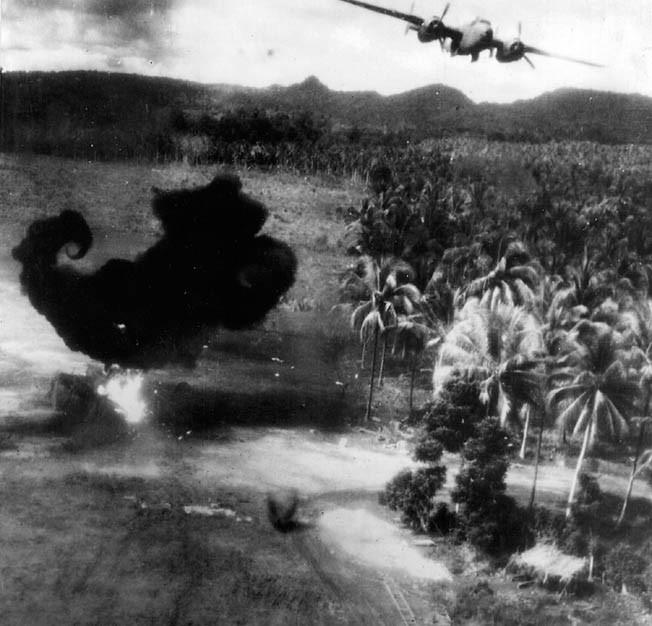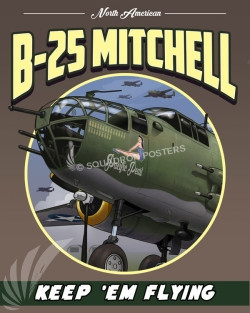That day when American Pilots stole two dozen Bombers:
When war came to the nation in December 1941, the 13th Bomb Squadron known as the “Reapers” (joined with the 3d Attack Group), embarked on an accelerated training program while also engaged in anti-submarine patrols against German U-boats along the Atlantic coast. Because every ranking and experienced man from the unit was pulled and assigned overseas to train other units, the Reapers were left without personnel and planes. When the unit arrived in Australia in January 1942, they were still without airplanes. While waiting for aircraft, the Reapers learned there were 24 brand new B-25s sitting on the ramp in nearby Melbourne, but the planes were earmarked for the Dutch. Soon after, 24 Reaper pilots arrived in Melbourne, presented a confused Officer of the Day with an authorization letter, and nonchalantly flew away with the (stolen) airplanes before anyone realized the mistake. The Reapers used those planes, and later A- 20s, to attack bridges, transports, airfields, troop installations, seaplanes, docks, warehouses and enemy targets.
The Doolittle Raid on Tokyo is the most famous mission flown by B-25s, but it was far from the most important, nor was it the first. Several weeks before Jimmy Doolittle led his men off of Hornet on what the crews thought was a suicide mission, a seemingly insignificant event occurred at an airfield near Melbourne, Australia. On March 27, 1942, a C-47 landed at the airfield where a dozen or so B-25s that had been consigned to the Dutch had been parked after being ferried from the United States. Out of the airplane stepped Lt. Col. John “Big Jim” Davies, the former commander of the 27th Bombardment Group and the new commander of the recently arrived Third Attack Group.
Jim Davies was accompanied by two dozen of his pilots. One of the pilots was a formerly retired US Navy enlisted pilot who was now Captain Paul I. Gunn, U.S. Army, and the commander of air transport in Australia. Davies found the officer responsible for the airplanes and presented orders transferring them to the U.S. Army and authorizing him and his crews to pick them up and take them north. The orders had been obtained from Brig. Gen. Eugene Eubank, commander of V Bomber Command, through a process of “shuck and jive” that Gunn suggested to Davies after he found the brand-new airplanes sitting idly on a ramp after their delivery to Melbourne.
Captain Paul Gunn, or “Pappy”, as the men of the 3rd Attack Group had begun calling him, was one of the true characters of World War II, and one of the most important. Author Walter D. Edmonds would say of him, “No other person below senior officer rank would make as much of a contribution to the war in the Pacific,” and much of it would involve the B-25. In fact, it was Gunn who first learned that the B-25s were in Australia, and it was he who concocted the plan to literally steal them from the Dutch.
As far as Gunn was concerned, it was a tragedy for the B-25s to sit idle until the Dutch could train crews for them when there were available American and Australian aircrews with a war to fight. Furthermore, once Davies and his men returned to their base at Charter Towers and discovered that there were no bombsights for the airplanes, Gunn returned to Melbourne and “got them” too. According to the men of the Third Attack Group, when the Dutch refused to give up the bombsights, Gunn presented his authority in the form of a Thompson submachine gun—and got the bombsights.
Naturally, Gunn “took” one of the airplanes for himself. With the scrounging of the B-25s, Gunn became a member of the Third Attack Group the following day; he was relieved of his duties as commander of the 21st Transport Squadron and transferred to the bombers on orders dated March 28, 1942.
Until Davies and Gunn “purloined” the B-25s, the only U.S. offensive aircraft in Australia were a few Douglas A-24 Dauntless dive-bombers that originally had been bound for the Philippines and which had just returned from Java, and a handful of war-weary Boeing B-17s. A B-26 group was on the way to Australia, but would not become operational for several weeks.

The B-25s Dropped Four 300-Pound Bombs on the Airfield
Although the Dauntlesses would devastate the Japanese fleet at Midway a few weeks later, they were poorly suited for the kind of combat Allied aircrews were enduring in New Guinea. They lacked the armament for self-defense and were so slow that Japanese fighters could easily intercept them. After particularly heavy losses on a mission to Buna in July, Colonel Davies decreed that none of his men would go into combat again in the slow and poorly armed dive-bombers. Consequently, the B-25s were a Godsend.
By April 6, while the Tokyo Raiders were crossing the Pacific on the Hornet, Pappy Gunn had the B-25s ready for combat and they flew their first mission against the Japanese airfield at Gasmata. Each of the 12 B-25s dropped four 300-pound bombs on the airfield, with about half of them exploding among the parked airplanes. Suddenly, the Japanese were suffering the experiences of the Americans at Clark Field on December 8, 1941. Reportedly, at least 30 Japanese bombers were destroyed in the attack.
Had the the U.S Air Force (13th Bomb Squadron, 3d Attack Group) not stole these two dozen Bombers mission success would not have been possible!
At the end of the war, the 13th Bomb Squadron had earned four Distinguished Unit Citations for actions over the Philippine Island, Papua and New Guinea, and also took home the Philippine Presidential Unit Citation.
The 13th Bomb Squadron Today
Today the 13th Bomb Squadron (13 BS) is still an active squadron and one of the oldest units in the United States Air Force, first being organized as the 13th Aero Squadron on 14 June 1917 at Kelly Field, Texas. The squadron deployed to France and fought on the Western Front during World War I as a “pursuit squadron”. – It is currently assigned to the 509th Operations Group, Air Force Global Strike Command, stationed at Whiteman Air Force Base, Missouri and is equipped with the remarkable B-2 Spirit Stealth Bomer.
Source: Warfare History Network
http://warfarehistorynetwork.com/daily/wwii/the-north-american-b-25-mitchell-bomber/

